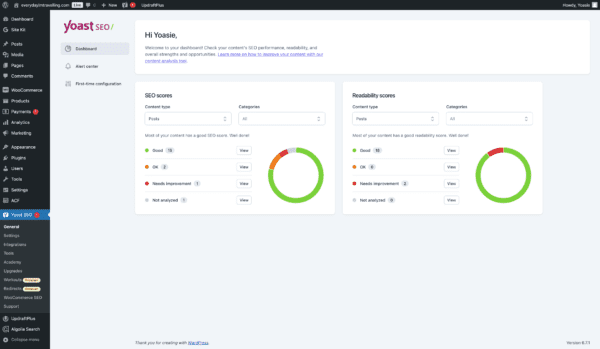A lasting relationship with an enterprise client is good for business. It gives you authority, it gives your staff exposure to how large organizations work, and there should be a financial element.
But winning the pitch is just the beginning. Many agencies make the grave mistake of misunderstanding their role in the relationship, and it is this: The relationship is transactional – at least, at first.
This is what an enterprise client needs from you:
- Clear, consistent communication.
- Alignment with business objectives.
- Flexibility.
- Integrity.
- Operational efficiency and responsiveness.
- Proactive problem-solving.
In many ways, these six things overlap on a Venn diagram. And when you get it right, we will see you not as an external vendor but as an extension of ourselves.
1. Clear, Concise Communication
Enterprise clients don’t just want emails or reports. They want clarity, alignment, and confidence that you’re on the same page.
If they’re left guessing what’s happening, you’re failing.
Always ask yourself: What is the message you wish to convey?
Oftentimes, less is more.
Instead of a lengthy email, sometimes a 15-minute Teams call will not only address the topic but also the bigger picture and the next steps. But this doesn’t mean long emails don’t have a place—they do.
Context is everything.
I get it – it’s purely subjective from one point-of-contact to the next. But that’s the name of the game.
Be adaptable, and don’t assume. Reach out and ask how your point-of-contact prefers to communicate.
At the start of every engagement, even when I was agency-side, I would ask for clear directions on ways of working.
And lastly, before you hit send, ask yourself: Does this have to be mentioned/asked/challenged right now?
How to do this effectively:
- Send a pre-read ahead of time. Strive for two business days ahead of time, 24 hours worse case.
- Include an executive summary at the beginning of every presentation. There is nothing worse than having skim reading a deck full of slides without an executive summary. I’m busy. My boss is busy; their boss is busy. If you’ve made the effort to create a presentation deck, put a TL;DR at the front for us.
- Sign up to use the same team collaboration app as your client for quick updates. Most people don’t reply to emails immediately. Instant messaging such as Slack or Teams? Completely different rules. Plus, I speak from personal experience that shooting a Slack message in a dedicated channel takes far less mental bandwidth than crafting an email. The best part is that it works both ways, so win-win!
Here’s the truth: Great communication reduces friction, builds trust, and keeps you in the loop when priorities shift.
2. Alignment With Business Goals
Increasing quarter-on-quarter traffic is nice. Rankings are cool. But if you’re not moving the needle on their actual business goals – revenue, customer retention, market share – you’re just noise.
The biggest lesson I learned when moving agency-side to client-side was this: If your recommendation doesn’t ladder up directly to business goals, then you’re wasting everyone’s time with your research, audits, and recommendations.
And, as SEO professionals, we default to problem identification mode because that’s how most of us got started. That is, find all the problems related to a particular pillar (e.g., content, technical SEO, off-page) and mistake this list as the strategy.
This is what I did the first week I started my first enterprise SEO role.
I fired up Screaming Frog and found all the things.
But I had no context as to who was responsible for resolving each issue and what their priorities were.
What may seem like an important SEO activity may not be a business priority.
How to do this effectively:
- Transparency goes both ways. Just as an enterprise client expects you to be transparent, you can as well by asking what their strategic pillars are for the quarter or year. To go a step further, get tangible guidance by requesting your point-of-contact what their objectives and key results (OKRs) are. Trust me, they’ll have them because that’s corporate life.
- Bring the right people along the journey. If you wish to propose adding content, ask your point-of-contact what stakeholders are involved in making this change happen. If you’ve discovered crawling, indexing, and rendering issues, ask who can make changes to robots.txt, to the , and to the frontend stack. Chances are, they’re all separate teams who work in their own silos and backlogs.
The lesson is this: Your role is not to fix all the things because you simply cannot. Instead, take a minute to understand who’s who because even your point-of-contact is an advocate, not an executioner.
Why this matters: Clients don’t want SEO in a silo. We want strategies that tie into our biggest priorities.
Why? Because our performance review and bonuses rely on them. So, speak our language and show us how SEO helps us win.
3. Flexibility
Markets change. Leadership changes direction. Enterprise clients want partners who can adapt to their evolving needs without skipping a beat.
I don’t care that you’ve sunk 80 hours into something I asked you to do. I only care about what is top-of-mind right now.
It’s nothing personal. I probably feel frustrated, just as you are. But priorities shift, so learn to go with the flow and be an asset instead of a blocker.
When you’ve got my back, I’ve got yours because we’re in this together.
The key: Be agile. Show that you’re not just a plan-follower but a partner who can pivot without losing focus on results.
4. Integrity
Integrity is the currency of trust. Enterprise clients need to know they can rely on you to tell the truth, even when it’s inconvenient or uncomfortable.
If there’s a mistake, own it. If timelines slip, address it early. If you think the client’s ask won’t work, say so – and back it up with data or reasoning. The worst thing you can do is over-promise and under-deliver.
Recently, a vendor blamed their lack of access to a Sharepoint file.
Perhaps it was true; Sharepoint can be fickle with external vendors. But the fact that this was their explanation when I asked why there was a delay in the delivery disappointed me greatly.
In my mind, I assumed they were overextended and did not get around to the task.
There’s a really easy fix to this: Every time your client shares a file with you, open it and see if you have the required access. Don’t wait two weeks later because that’s too late and sends a very bad message.
Similarly, not all campaigns go to plan. For example, perhaps your digital PR campaign didn’t produce the results you expected. That’s fine.
The second worst thing you can do is lie about it. The worst thing you can do is buy backlinks to pad the numbers.
Enterprise search marketers know that there are no guarantees with Google. What my boss, their boss, and their boss expect are learnings.
What did we learn from this exercise?
What can we do better next time?
Did we document what we didn’t plan and why in a wiki so that we don’t make the same investment in something that doesn’t work?
The flip side of this is to stand up for yourself because I’m not looking for a lackey. Not every idea I come up with is appropriate, and I expect – no, rely on – you to tell the truth even when it’s inconvenient or uncomfortable.
5. Operational Efficiency And Responsiveness
Enterprise projects are a symphony of moving parts, and delays in one area can cascade into chaos. Your job is to deliver fast, precise work while minimizing bottlenecks.
I think most enterprise SEO professionals will agree with me on this – my calendar is full. On some days, it’s literally back-to-back meetings with different stakeholders.
I don’t have the time or mental bandwidth to hold your hand.
When I give you a task, speed matters – not just for execution but for acknowledgment. A simple “We’re on it, here’s when you can expect an update” goes a long way in showing you’re reliable.
Efficiency isn’t just about working quickly – it’s about working smart. Streamline processes, remove redundancies, and bring structure to chaos. Help us feel like we’re in capable hands, no matter how derailed the project gets.
The play: Deliver fast, precise work, and be responsive. They’ll keep coming back to the agency that gets it done.
6. Proactive Problem-Solving Without Access To First-Party Data
Enterprise clients often operate in silos, and as an external agency, you’re rarely handed direct access to our analytics platforms.
Limited access to first-party data is the norm, but that doesn’t excuse you from identifying issues or presenting solutions.
The best agencies thrive under constraints. If you don’t have access to first-party data, get creative with proxies. Use publicly available tools, competitive analysis, and trend data to craft recommendations.
When possible, suggest ways the client can share aggregated insights or anonymized data that protect internal policies while giving you enough to work with.
Your goal is to demonstrate that you can solve problems without needing to see everything. And if data gaps are creating risks, flag them early.
Be proactive in suggesting solutions, such as data clean rooms or integrations that can provide the insights you need without breaching compliance.
Do this instead: Leverage external data sources.
If there’s one thing I know from working agency-side, it is that you have access to all the tools. So, pull insights from other data sources to identify patterns and opportunities.
Why this matters: First-party data is a privilege, not a given. By showing that you can deliver value despite limitations, you position yourself as a resilient, resourceful partner who doesn’t let obstacles stand in the way of results.
The 6 Pillars Of Enterprise SEO Success
Enterprise clients don’t just want vendors. We want long-term partners because procurement and onboarding are painful.
Here’s what we value most:
- Clear communication that aligns and inspires.
- Strategies tied directly to business outcomes.
- Agility in the face of shifting priorities.
- Integrity and transparency in every interaction.
- Efficiency that respects our time and resources.
- Creative problem-solving that delivers results, even under constraints.
Master these six pillars, and you’ll become more than a service provider. You’ll be a partner we fight to keep.
More resources:
Featured Image: wee dezign/Shutterstock






























